Washington DCs monument to black history

The National Museum of African American History and Culture, completed by UK architect David Adjaye, opens this week
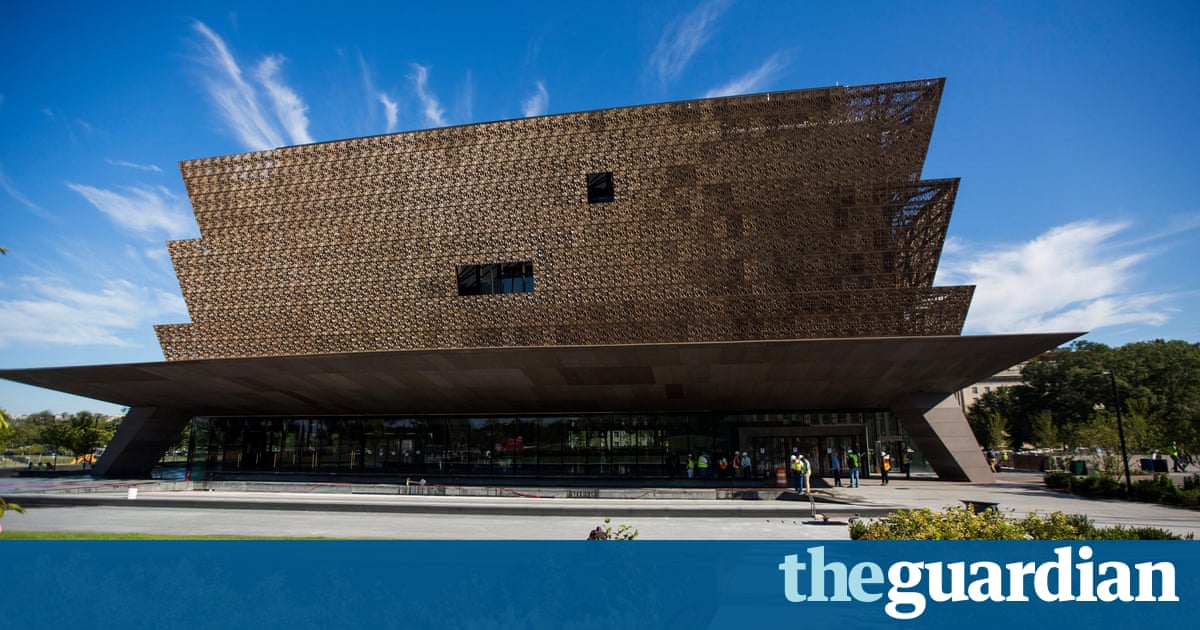
As a general rule, it was written in the 1920s, Negroes have not been and are not thought of in America when you talk in general terms of Americans unless they are specifically pointed out. This general forgetfulness therefore made it necessary for those interested in fair play to all citizens to propose a beautiful building to depict the negros contribution to America in military service, in art, literature, invention, science, industry etc.
The text was part of a century-long campaign, started by black civil war veterans in 1915, that will reach its fulfilment on Saturday, when Barack Obama formally opens the National Museum of African American History and Culture in Washington DC. It describes with some precision what has finally been achieved. It also suggests what the museums director, Lonnie Bunch, says over and over: that the museum should give a fuller understanding of what it means to be American seen through the particular lens of black experiences and contributions, not a place that is just about and for an anthropologically defined category known as African Americans.
The moment, of course, is charged. A short walk away another building has opened in the heart of the federal administrative district: the chandelier-bedecked Trump International hotel, a possible encampment on the way to the White House for the man keen on the plainly racist fantasy that Obama was not really American-born, and who as a young property tycoon was accused of denying homes to black applicants. Trumps combinations of obfuscation, cunning, bluster and force follow a pattern seen across the centuries in the museums accounts of the ways in which black freedom and advancement were blocked.
The museum, the 19th to be created by the Smithsonian Institution, enacts further principles currently under attack, which are the importance of knowledge and fact, scrupulously gathered, and of shared spaces for their understanding. It is much for a single building and its contents to carry, especially one placed on the National Mall in Washington amid the icons of the nation the White House, the Capitol, great museums, memorials to wars and presidents. How does one compete with such a monumental landscape? asks David Adjaye, the lead designer of an architectural team formed out of four practices for the purpose of this project called Freelon Adjaye Bond/SmithGroup.

This team is led by people of predominantly African American heritage, a rarity in the still very white profession of architecture, such as the lead architect Phil Freelon and the project leader Zena Howard. J Max Bond, a pioneer among black architects, was part of the group but died before the museum was finished. Adjaye is British, born in Tanzania to Ghanaian parents. The theme and content of the museum is therefore personal. As a young boy of my generation the African American story was also our story, says Adjaye, who was born as the civil rights movement was gathering force in 1966, in the sense that it was the techniques, the motivation, it was a way of being and it was a way of understanding that one could succeed in the modern world and not be oppressed by it. I feel it as part of my emerging into adulthood and being who I am.
It is indeed the content that should come before the architecture of the building that serves it. It includes artefacts of desperation and sheer survival, such as the shards of tools used by Maroons escaped slaves in their refuge in the Great Dismal Swamp of North Carolina. Also of violence, such as leg irons, and fragments of glass from the 1963 bombing that killed four young girls in the 16th Street Baptist Church in Birmingham, Alabama. There is exaltation, in the form of one of Chuck Berrys bright red Cadillacs, of the recollected triumphs of Muhammad Ali, of the orange silk jacket and recorded singing of the contralto Marian Anderson. There is abundant film and photography of the struggles and grotesqueries of racial politics, such as the Ku Klux Klan march through Washington in 1925.
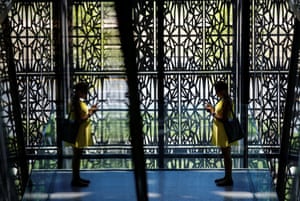
Scraps of intimacy and poverty are interspersed with larger structures, such as wooden cabins inhabited by slaves and a watchtower from Angola prison in Louisiana. Objects of American transport technology contribute: a segregated railway carriage, a bright yellow-and-blue biplane used by the African American Tuskegee airmen, that Cadillac. Eventually you find the P-Funk Mothership, a spoof spacecraft that used to land on stage on the 1970s stadium tours of George Clinton and his band Parliament-Funkadelic.
The collection is remarkable for the fact that, little more than a decade ago, it didnt exist. Lonnie Bunch, on taking up his post in 2005, was armed with a Bush-signed act of Congress that supported the idea of the museum, but he had nothing to put in it. This could have been catastrophic, as the world is full of unconvincing museums founded on ideas but little content. So Bunch and his team toured the nation, inviting people to offer whatever they might have. The result is personal, eclectic, touching and surprising, rather than encyclopedic.
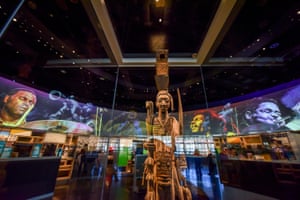
The displays are sometimes overcrowded but avoid gimmicks and pointless gestures at interaction. They are text-heavy, partly to fill the gaps that arise from the nature of the collection, with a measured and sober tone. The exhibits are arranged in three main sections, starting with a narrative history, rising up from the bottom of a deep basement, that runs from the beginnings of the Atlantic slave trade in 15th-century Africa and Europe to the presidency of Barack Obama. On two upper floors, above the ground level entrance hall, are the community galleries, which talk about such things as religion, place, sport and military service, and the culture galleries, which show art, music, literature and performance.

The museum thus climbs from slave ships to the mothership, an ascendant trajectory that maybe doesnt do enough to avoid an oversimplified story of oppression ultimately redeemed by blues, funk and hip-hop. The museum nonetheless does an outstanding job of giving due weight to horrors and heroism, to people just living their lives and to the endless repeating stories of creativity prompted by oppression. Many of the histories are familiar even to non-Americans, such as that of Rosa Parks, but they are shown here with new weight. You are assailed by the mental force of something pushing from the back of your mind to the front. Was segregation really so cruel, so laughably hypocritical, so absurdly rigged and transparently unfair? Yes, it was.
The official story of the design is already much told and doubtless will be repeated to the museums visitors for as long as it stands. The triple-decker superstructure of inverted truncated pyramids recalls the celebratory headpieces on certain Yoruba sculptures from west Africa and can also evoke, if you like, arms raised in celebration. They are made of bronze-finished aluminium whose filigree patterns derive from the decorative metalwork created by African American craftsmen in cities such as New Orleans and Charleston. A long, deep canopy that shelters the main entrance refers to the porches of southern houses that acted as social and political centres, little village halls, informal schools.
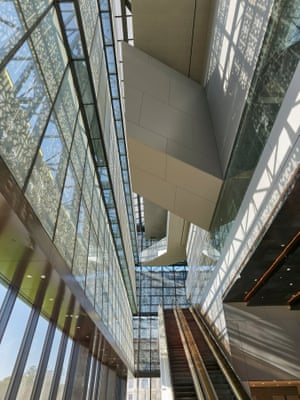
These narratives are necessary, says Adjaye, for a project that was definitely not done quietly on a mountain somewhere on my own but had to negotiate a lot of positions and opinions to get this form. So it was really important that this was neither cloaked nor hidden. It was something that had to be absolutely clear and people had to understand why.
But such stories only get a building so far. They could describe an exhilarating work or a cringe-making one. What matters more are the relationships the architecture makes through its space and material between exhibits, people and surroundings.
Here there are tensions between the institutional nature of a museum and its popular ambitions, between a search for authenticity and the tendency of modern museums to resemble shopping malls shiny, escalatored driven as they are by mall-like considerations of people moving and browsing. The design also has to deal with the contemporary habit of putting exhibitions in sealed boxes, where air and light are perfectly controlled, which makes for abrupt transitions with the rest of the world.
One technique that Adjaye tries is to create moments of crowd-pleasing charm a particular tone of purplish pink terrazzo in the entrance halls floor, coppery panels on the lifts, outbreaks of decoration as in an art deco cinema, something as simple as the rich blue over the entrance to the Oprah Winfrey theatre. There is an agile open loop of a spiral staircase going down to the basement, which also helps you forget that because of restrictions on the above-ground volume of buildings on the National Mall 60% of the museum is buried. You might imagine something non-Caucasian in these hues and motifs, but at any rate they are different from the greys and creams of most Smithsonian museums.
More substantially the building seeks to connect with its august surroundings, through views from decks outside the upper galleries that are sometimes filtered through the filigree screens and sometimes through openings specially oriented to particular monuments. The glass-walled ground floor allows views in all directions of both greenery and stone-pillared official architecture. At this point it feels embracing and inclusive.
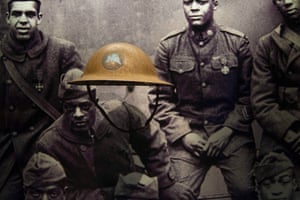
The hardest job the design has to do is to find a way to stand on its grand stage. It is placed at a corner where the grand axis emanating from the Capitol intersects at a right angle with that emanating from the White House, a cross pinned at its centre by the 555ft obelisk of the Washington monument. All around are white stone commemorations of white men, albeit often built with black labour. As a freestanding largely symmetrical object, the new museum has something in common with its neighbours, but as a dark-clad structure that eschews classical columns for apparently floating horizontal layers, it does not. Its suggestion of pyramids gives a geometrical echo of the obelisk (which, lest we forget, is Egyptian and therefore also African), but their inversion sets them apart.
Adjaye doesnt mind if a link is made between the dark skin of the building and that of the people it remembers, but he gives another reason for it. If it is not the main material for buildings on the National Mall, bronze is nonetheless used for the memorial detail of statuary and plaques. The role of the new museum is itself partly memorial, the idea having started off a century ago with the primary intent of honouring black soldiers. The bronze finish, for Adjaye, is absolutely from the classical family, but to express different ideas seemed like the right thing to do.
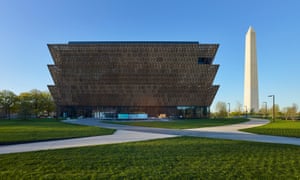
It takes some nerve to do a building like this, on this spot, and the design is confident enough to pull it off. It is not flawless, as it sometimes feels assembled or panellised more than crafted. The bronze-coloured screens are not the delicate, seamless things suggested in computer visualisations. The build-up of the exterior cladding glass wall plus screen plus substantial fixings for the latter impedes the sense of connection between inside and out. There are moments of gawkiness that can be engaging or uncomfortable, depending on your taste. But it achieves its main, difficult task, which is to be both American and African American, and to be of its location but also different from it.
As a museum and as a building it enacts the tone that is so striking in the 1928 text its patience, reason and lack of rancour. It realises qualities of America at its best, ones which, as is now abundantly clear, we cant take for granted.
A century of waiting: the long campaign for the museum
The new National Museum of African American History and Culture is the result of more than a century of efforts to commemorate the contributions of African Americans to their country.
1915 A group of civil war veterans, gathered to mark the 50th anniversary of its ending, organise a committee of colored citizens to build a monument.
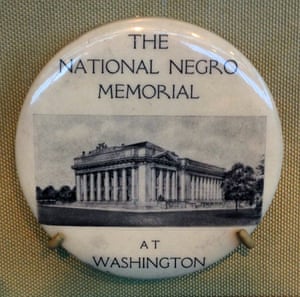
1929 Congress permits a national commission to be set up, but it fails for lack of funding.
1968 Black leaders unsuccessfully press Congress for a museum.
1985 The owner of a bus-tour company, Tom Mack, starts a fundraising group.
1988 Congressman John Lewis, a civil rights veteran, unsuccessfully introduces a bill for a museum. He continues this battle for 15 years.
1994 A proposal to create a museum within a wing of an existing Smithsonian institution, already controversial because of its lack of ambition, is defeated. Republican senator Jesse Helms opposes it: How can Congress then say no to Hispanics, he says, and the next group, and the next group after that?
2003 After bipartisan pressure George Bush signs legislation creating the National Museum of African American History and Culture.
2005 Lonnie Bunch is appointed director. The museum has a staff of two, no collection, no confirmed site, and needs to raise hundreds of millions of dollars. He launches Saving African American Treasures, a programme to encourage citizens to donate objects.
2006 A site is selected on the National Mall, Washington DC, the last of any size to remain undeveloped.
2009 Following the election of President Barack Obama, a team of architects is selected.
2016 The museum, designed by a team led by David Adjaye, is completed at a total cost of $540m. Its 37,000 exhibits range from the sombre to the joyful. They include the coffin of Emmett Till, the teenager who was mutilated and killed in 1955; the dazzling dresses of Whitney Houston and Dionne Warwick; and works by the self-taught 19th-century portrait painter Joshua Johnson.
Read more: https://www.theguardian.com/artanddesign/2016/sep/18/washington-dc-monument-to-black-history